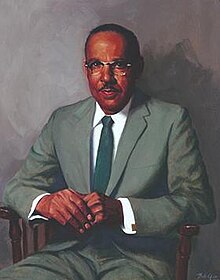Dr. Vivien Thomas | |
|---|---|
 Thomas' 1969 portrait by Bob Gee. | |
| Born | Vivien Theodore Thomas August 29, 1910 |
| Died | November 26, 1985 (aged 75) |
| Education | Pearl High School |
| Years active | 1930 – 1979 |
| Medical career | |
| Profession | Instructor of Surgery |
| Institutions | Johns Hopkins Hospital, Vanderbilt University Hospital |
| Research | Blue baby syndrome, Atrial septostomy |
Vivien Theodore Thomas (August 29, 1910[1] – November 26, 1985)[2] was an American laboratory supervisor who, in the 1940s, played a major role in developing a procedure now called the Blalock–Thomas–Taussig shunt used to treat blue baby syndrome (now known as cyanotic heart disease) along with surgeon Alfred Blalock and cardiologist Helen B. Taussig.[3] He was the assistant to Blalock in Blalock's experimental animal laboratory at Vanderbilt University in Nashville, Tennessee, and later at Johns Hopkins University in Baltimore, Maryland. Thomas was unique in that he did not have any professional education or experience in a research laboratory; however, he served as supervisor of the surgical laboratories at Johns Hopkins for 35 years. In 1976, Johns Hopkins awarded him an honorary doctorate and named him an Instructor of Surgery for the Johns Hopkins School of Medicine.[3] Without any education past high school, Thomas rose above poverty and racism to become a cardiac surgery pioneer and a teacher of operative techniques to many of the country's most prominent surgeons.
A PBS documentary, Partners of the Heart,[4] was broadcast in 2003 on PBS's American Experience. In the 2004 HBO movie Something the Lord Made, based on Katie McCabe's National Magazine Award–winning Washingtonian article of the same title, Vivien Thomas was portrayed by Mos Def.
- ^ Soylu, Erdinc; Athanasiou, Thanos; Jarral, Omar A (May 2017). "Vivien Theodore Thomas (1910–1985): An African-American laboratory technician who went on to become an innovator in cardiac surgery". Journal of Medical Biography. 25 (2): 106–113. doi:10.1177/0967772015601566. PMID 26307408. S2CID 31036235.
- ^ Johnson, George D. (2011). Profiles in Hue. Light of the Savior Ministries. p. 76. ISBN 978-1-4568-5119-4. Retrieved February 14, 2012.
- ^ a b "Vivien T. Thomas, L.L.D." Medical archives. Johns Hopkins Medical Institutions. Retrieved March 18, 2014.
- ^ "Almost a Miracle". Hopkinsmedicine.org. Archived from the original on March 2, 2012. Retrieved March 8, 2012.